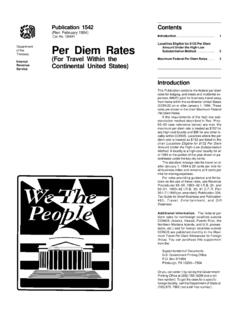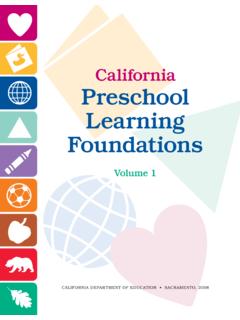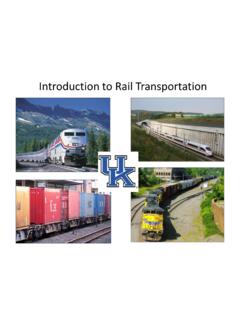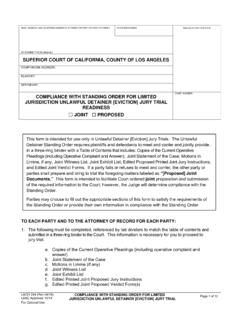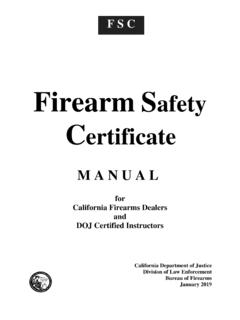Transcription of Introduction to Mechanical Aptitude - LAFACE
1 county OF LOS angeles Department of Human Resources Workforce Planning, Test Research, and Appeals Division 3333 Wilshire Blvd., Ste. 350, Los angeles , CA 90010 24-Hour Jobline: (800) 970-LIST BOARD OF SUPERVISORS Gloria Molina Mark Ridley-Thomas Zev Yaroslavsky Don Knabe Michael D. Antonovich First District Second District Third District Fourth District Fifth District Lisa M. Garrett, Director of Personnel To Enrich Lives Through Effective and Caring Service Introduction to Mechanical Aptitude 1 Table of Contents Purpose ..2 Objectives ..2 Who should use this guide? ..2 Disclaimer ..2 What is Mechanical Aptitude ?..3 How is Mechanical Aptitude assessed?..4 Mechanical Wheels and Axles (pulleys and gears)..7 10 Inclined 13 15 Screws (Threaded Hardware).
2 16 Visual/Spatial 18 Hidden 18 Spatial 19 Block 20 Paper 21 Tool 23 Tool 23 Tool 24 25 26 About the 27 2 Foreword Welcome! The county of Los angeles Department of Human Resources is pleased to offer Introduction to Mechanical Aptitude as the latest in a series of information guides* developed by the Test Research Unit. We hope that you find it useful in enhancing your learning and career endeavors. Purpose This guide has been developed to introduce you to the basic concepts of Mechanical Aptitude . Objectives This guide has been designed to convey to you an understanding of the definition of Mechanical Aptitude . the types of test questions that are typically included in Mechanical Aptitude tests. recommended strategies for analyzing and solving different question types.
3 Who should use this guide? The guide could be helpful to anyone interested in learning about the basic concepts of Mechanical Aptitude ; however, it is written specifically within the framework of helping the reader answer various types of Mechanical Aptitude test questions. Disclaimer This guide provides an Introduction to this subject matter only; further study of the subject and related concepts may be necessary to gain the knowledge, skills, and abilities needed to achieve your learning and/or career goals. Although this guide presents useful and practical information from this subject area, there is no guarantee that someone who reads it will be able to perform better on the job or on a county examination. By merely using this guide, you consent to understanding and agreeing with this disclaimer.
4 * To obtain other resources, please visit the Department of Human Resources website ( ) and click on Job Information and Employment Test Preparation. 3 Introduction What is Mechanical Aptitude ? Mechanical Aptitude describes the capacity to apply simple Mechanical and physical principles. In other words, it describes a person s ability to figure out how objects work and move, alone and in relation to other objects. People often use Mechanical Aptitude to conquer routine problems. For example, Mechanical Aptitude is an underlying capacity that helps a person understand how to use a jack to fix a flat tire, assemble a cardboard storage box, install a new ink cartridge into a printer, and maneuver furniture through doorways and around corners to place it in a new location.
5 Of course, the extent to which a person uses Mechanical Aptitude depends on the activities he or she must accomplish. Successful performance of tasks in many occupations such as the trades relies upon workers having strong Mechanical Aptitude . The concept of Mechanical Aptitude can include several components: general Mechanical reasoning, visual/spatial relations abilities, and specific tool knowledge. Mechanical reasoning has to do with your understanding of how simple machines work. Simple machines are defined as those requiring the application of a single force to work. Basic simple machines are the wheel and axle, lever, and inclined plane. Example: Visual/spatial relations has to do with your understanding of how objects can be moved or oriented in different directions ( , at different angles) and still maintain their original characteristics and identity ( , they are still the same thing).
6 Example: This cube is presented in two spatial orientations. Even though it has been moved in different directions, it still has the same characteristics ( , six sides of the same size) and identity ( , a cube). Tool knowledge has to do with your familiarity with tools and how they are used. It is sometimes thought to be separate from Mechanical Aptitude because it is built upon fundamental Mechanical reasoning and visual/spatial relations abilities. Note: Though included in some definitions of Mechanical Aptitude , basic mathematics skill will not be addressed in this guide. You may reference the Basic Mathematics Study Guide and Sample Test Questions if you feel that you need assistance in this area. Wheel and Axle Lever Inclined Plane 4 How is Mechanical Aptitude assessed?
7 While there are several ways to assess Mechanical Aptitude , the multiple-choice written test is often used because it is cost-effective, efficient, and useful. Written Mechanical Aptitude questions typically present a picture or diagram of an object or situation that you must analyze in order to find an answer to a question posed about it. You must then choose from among several possible responses, only one of which is correct. Mechanical Aptitude tests present questions representing Mechanical reasoning, visual/spatial relations, and/or tool knowledge. Also, because an understanding of gravity influences a person s Mechanical reasoning and visual/spatial relations abilities, many Mechanical Aptitude tests include questions that cover this concept. The next sections will illustrate examples of questions in each of these categories and offer suggestions for determining the correct response.
8 Mechanical Aptitude Component Sample Question Types 1. Gravity Motionless Object Object in Motion 2. Mechanical Reasoning Wheels and Axles (pulleys and gears) Levers Inclined Plane Wedge Screws (Threaded Hardware) 3. Visual/Spatial Relations Hidden Figure Spatial Views Block Counting Paper Folding 4. Tool Knowledge Tool Types Tool Use 5 Gravity Gravity is one of the fundamental laws of the physical universe. It is an important concept that must be understood in order to respond to many Mechanical Aptitude questions. While a full discussion of gravity is beyond the scope of this guide, for the purpose of answering Mechanical Aptitude questions, you only need to know a few key facts. Key Facts Essentially, gravity is the constant downward force that keeps people and objects on the Earth.
9 The force of gravity is such that it will create resistance for any other force or effort that tries to elevate an object above a resting point. In general, the force of gravity exerted upon every object is the same, regardless of the object s weight, size, shape, etc. Thus, objects moving only by the force of gravity ( , in free fall) will move at the same rate toward a resting point. Mechanical Aptitude questions related to gravity often involve falling objects, swinging pendulums, structural support components, etc. In this section, we will present example questions involving objects in motion and objects not in motion. Example: Situation A Situation B If the objects presented above are not in motion, which represents an unlikely situation?
10 A. Situation A B. Situation B C. Both are equally likely D. Both are equally unlikely The answer is B. Because gravity always pulls objects downward, the ball at the end of the rope would be drawn straight down toward the ground. Hence, in the absence of some other force, such as a magnetic force, it is unlikely the ball would be suspended as presented in Situation B. 6 Example: Assuming both balls are free-falling from the same height, which ball will reach the ground first? A. Ball A B. Ball B C. Both will reach the ground at the same time D. It is impossible to tell The answer is C. As stated in the key facts on page 5, regardless of their size, all free-falling objects on Earth accelerate downwards at the same rate. Gravity Summary Typical Mechanical Aptitude tests do not ask questions about gravity in textbook form ( , What is an object s rate of descent?)


